growing
Exotic
Succulents & Cacti
outside & unprotected in the UK
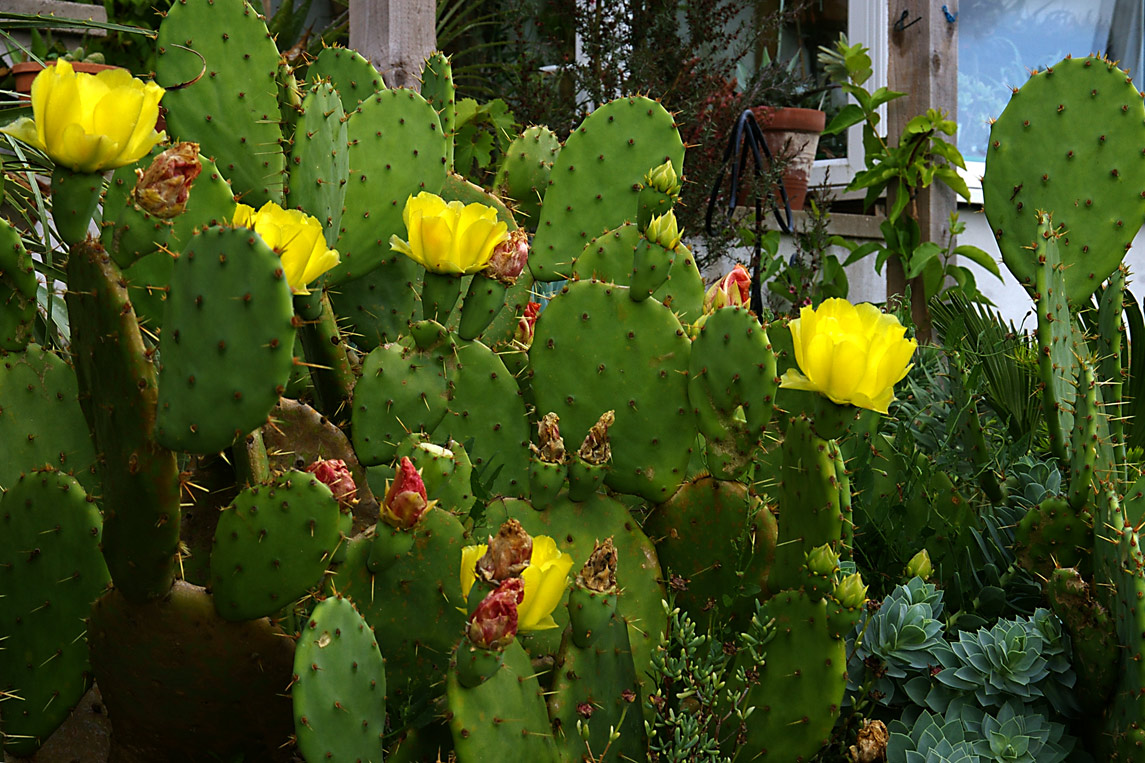 |
| A clump of hardy opuntias (details of species unknown) growing on a well-drained bank on the south-facing terraces in the rear garden. Under such conditions the opuntias are fully hardy here in Torquay. Prior to planting they had been knocking around and flowering in soilless buckets and pots for a couple of years. I obtained them from an enthusiast who had been growing outside in a very cold part of Torquay for about forty years. A Euphorbia myrsinites peeps out in the lower right-hand corner. |
General
The word 'succulent' is used to describe are plants which are able to store and conserve moisture and can therefore withstand long waterless periods that occur, for example, in deserts or rocky soil-less mountainous areas. Succulents are also often tolerant of high temperatures and indeed many require high temperatures for optimal growth. Thick leaves and stems are both characteristic features of succulents. When adequate moisture is available the plants are moist and watery inside but during dry periods they can lose many times their weight in water. In this sense cacti are also succulents despite being generally referred to and described separately. Many succulents are of course fully hardy in all parts of the UK - Sedum and Sempervivum immediately spring to mind but there are others less commonly grown: Lewisa, Yucca, Orostachys.
Many years ago when I had my first garden in West Sussex I grew sedums (including ice plants), Sempervivum and Euphorbia mysinites. These plants were easy and required no special attention. I struggled with Echeveria whose vulnerability to winter rot would impress the most apathetic and each spring I added an agave or two to the compost heap. Now, I am sure that I could have done better - even in Bognor Regis. In Torquay, however, I was surprised to discover the great variety of succulents which can be grown - ones that at fisrt sight would appear tender and totally unsuited to our climate.
Succulents, of course, are associated both in the mind and in their natural environment with dryness and therefore any attempt to 'twist' reality for example, by placing a sub-tropical succulent in a bog garden will end in a double failure: firstly, the juxtaposition will appear incongruous even ludicrous and, secondly, it will be followed shortly by the demise of the plant. An extreme example perhaps but I have seen something similar time and time again in its milder manifestations in the gardens of friends and acquaintances . The main rules are, therefore, 'keep the plants dry' and 'ensure that it looks dry where they grow'. At the same time it must be noted that there are numerous exceptions where they require copious watering and a shady position; some do not and react badly to over-heating.
The majority of succulents originate in areas of summer rainfall. Their period of growth is the summer and in the winter they become dormant. Such plants are simply not designed to be drenched, subject to close to 100% humidity and have fungal spores coming at them from all directions. Ideally they require to be fully dry. Typical of this group are the agaves and cacti. However, some succulents come from areas of winter rainfall - from climates we refer to as Mediterranean. These plants slow down during summer due to lack of moisture and make growth during late autumn and early spring whilst not really stopping during winter. Such plant could rot during summer, if over-watered but this is not common. In the Torquay area, not an area that lacks rain, the bulk of the annual rainfall occurs during winter when soil saturation levels can remain high for months. Correct conditions must be given for agaves and cacti to grow happily. Here Mediterranean plants are less at risk provided temperatures do not drop too low. Thus aeoniums from the Canary Islands, Drosanthemum and Lamprathus from the Cape area of South Africa and Carpobrotus from various locations worldwide are successful here. To achieve success it is therefore important to understand the native environment of the plants to be grown.
Of all the various conditions generally mentioned for the growing of succulents (both in pots and in the ground) all fall into two main areas: soil type and position. While all plants are variously affected by soil and position, otherwise hardy succulents can be killed quickly and effectively by not getting these two absolutely right. In principle, the requirements seem quite easy to meet. Soil: very well-drained, dry in winter, preferably neutral or slightly acid. Position: as much sun as possible (at least for most of the day), as much heat as possible, shelter from wind and driving rain, preferably on a south-facing slope and against a wall of a house. The vast majority of failures of succulents result from problems with these requirements - even the rock-hardy sempervivum will struggle and eventually give up in damp shade; and this can mean even in the shade of other plants. The general difficulty with these requirements is that they often require a degree of hard work in order to achieve the optimal state.
In terms of general guidelines for soil I would recommend a 50:50 mixture of grit (anything along the lines of horticultural or Cornish) over an area of at least 18" (45 cms) in diameter around each plant all to a depth of some 18" (45 cms). If the soil is limey, add a couple or three shovelfulls of moss peat to the mixture; if the soil is clayey add 50% more grit. The grit should ensure that the roots at least in the immediate vicinity of the plant are never waterlogged. Added to this, the plant itself will benefit if it is planted directly into a small 3-5 litre pocket of pure grit. The roots will, of course, penetrate the surrounding soil in their search for nutrients.
One danger to look out for is to ensure that the whole pocket of gritty soil does not itself sit in a pool of water. This can easily happen in a clayey soil, especially during the winter months. Such a situation will mean that the gritty soil is not able to ensure that air circulates around the roots and consequently
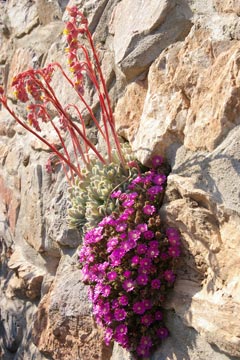 |
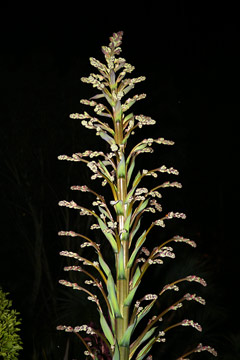 |
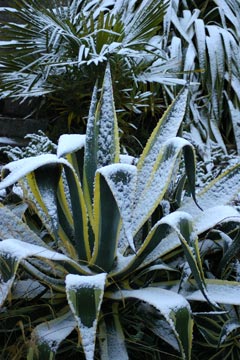 |
| One of the most successful and visually pleasing ways of growing exotic succulents is in the gaps between the stones of a south-facing wall. Here Echeveria is growing next to a Drosanthemum hispidum in a south-facing retaining wall in the rear garden. Here conditions are optimal: good drainage, ample light and heat, no competition from other plants. | A night shot of a developing flower stem on a Furcraea longaeva. This plant belongs to the agave family or Agavaceae and, like Agave species it is monocarpic (dies after flowering). Also, like some other members of the family, furcaeas produce bulbils - miniature plants - as well a seeds on the flower stem after flowering. The new plants from the bulbils are genetically identical to the parent. Furcraea is very closely related to the agaves and at first sight appears to be ones of them; however, its degree of 'succulence' is a good deal lower as is obvious from the thickness of the leaves. | Agave salmiana angustifolia 'Variegata' during the winter 2010-2011. Although the cold spell was relatively severe and lasted long this agave suffered only minor damage and was again looking its best as early as June. Very cold, short spells are less harmfull than prolonged damp spells oscillating around 0°C. Such conditions are generally conducive to moulds which, because of the arrested growth of the plant, cannot easily be overcome. |
There are no hard and fast rules here and I have seen many people growing agaves and aloes successfully in ordinary soil. 'Suck it and see' the saying goes. However, the chances of survival and successful growth are vastly increased by taking such advice seriously.
Although most gardens do not have the landscape features to enable the immediate enjoyment of exotic succulents some modifications can be made. Raised beds, filled with a mixture of soil and grit (and peat if necessary) immediately spring to mind. It is important to ensure that water can easily drain out of the whole bed itself. Another, more interesting garden modification is to build a wall (at least 9" thick) which will support a south-facing bank which can, in turn be terraced1. If the wall rises well above the top level of the bank it will give the plants additional shelter and heat. The reverse side of the wall can be used in many ways: to support purpose built compost bins, to create a lean-to garden store or even to form one wall of a garden shed.
Most succulents like a lot of light and heat. It is as well to understand the essence of the problem we have in the U. K. regarding both of these resources. Light (and radiant heat directly from the sun) is less intense here than in lower latitudes for several reasons. Firstly, sunlight strikes our latitudes more obliquely than it does further south and therefore the concentration of heat and light per given area is less. Secondly, in the U. K. we have to contend with a greater number of relatively dull days when light levels are low. Thirdly, for much of the year the deviation from the vertical increases greatly while the daily period of illumination decreases, also greatly. This is not offset by the longer days during the spring and summer months simply because during early mornings and late evenings again light strikes the U. K. at a very oblique angle.
While all this sounds very pessimistic there are advantages which the U. K. and , in particular, the south-west of the U.K., has over many places in similar latitudes. These consist of the maritime climate, the warming effect of the Gulf Stream and the presence of the warmer part of the Atlantic Ocean upwind from the U. K.. Together these effects give a degree of winter warming, additional to the sun's radiant heat, and compensate somewhat for the dull winter months. There is not very much that we can do about long winters and dull weather apart from moving to more favourable locations in the south or to cities where human activity keeps temperatures a degree or so warmer than the surrounding countryside. However, by gardening on both natural and artificial south-facing slopes we can easily increase light and radiant heat to levels similar to those of warm temperate and even tropical latitudes. I am not alone in noting that south-facing slopes make a vast difference to succulent performance.
Shelter in gardens is generally best provided by the planting of appropriate shrubs and trees which break up and slow down the wind rather than by solid objects like fences and walls which often funnel wind currents, cause local increases in wind speed and produce undesirable eddies. However, with succulents stone walls are desirable because they store and reflect the sun's heat. This makes it even more important for shrubs and trees to be dotted around in order to alleviate any wind problems which may arise from existing walls.
One matter rarely if ever mentioned with regard to succulents is garden débris and its removal. Because all succulents are prone to winter rot it is important to remove fallen leaves and other detritus before winter fully sets in. Otherwise the plants will become covered in damp leaves, will begin to suffer and losses will occur. I find generally that the best time to do this is between mid-December and the beginning of January. This operation can be scheduled into the overall cleanup of the garden for the following spring - often the weather at that time is more conducive to gardening than what can typically occur in February and March. At Southern Comfort I also cut back the leaves of hellebores at this time because it is very much quicker than trying to avoid the tall flower stems at the beginning of spring. Succulents such as agaves and aloes require additional treatment. Many of these begin to gather fallen leaves in the vicinity of the growing point and where the base of the leaves meets the stem. This is a particularly vulnerable area during winter. Such leaves and other undesirable material can be removed by carefully hosing the affected areas. A jet of water directed sideways soon cleans up the plant. Any drops water left will soon dry. Please note that a jet of water causes virtaully no damage whereas poking around with a stick or other hard object can cause tiny would which, especially in winter, can easily become epicentres for rots and moulds.
Slugs and snails can be a nuisance. It is surprising how they can strip off layer after layer from seemingly tough-leaved plants like agaves and how they manage to navigate around the cruelly-sharp spines of opuntias. Such plants must be carefully protected because, unlike soft-leaved hostas and the like the effect of the molluscs' work remains visible for many years. Once the mollusc finds a weak spot it will return - following its slime trail - time and time again. Soon its friends will join in. It is best to surround the plants with grit and use a proven slug and snail killer. The only sensible one available is metaldehyde (ferrous oxide is far less effective)- available as slug pellets and as a dilutable emulsion. Slug pellets must be used sparingly and over a wide area and never built into piles around plants. In liquid form metaldehyde is best used from a small pressure sprayer (make it twice as concentrated as the recommended dose for watering cans) and lightly cover the leaves with a film of the liquid. In dry conditions it lasts for several days but leaves must be retreated after any rain. For those worried about the use of metaldehyde I have a few words. Metaldehyde is a non-persistent organic (it contains only the elements carbon, oxygen and hydrogen and no more), it has a half-life of only several days when used in the garden and, when ingested in small amounts, breaks down into acetaldehyde which is what is pumped around the bodies of those who suffer hangovers. I suppose, therefore, that the slugs succumb to death by hangover. I find metaldehyde very effective despite what much of the pro-slug lobby maintains.
Succulents in pots need to be protected from vine weevil. These slow-moving nocturnal beetles with the unpleasant-looking and sounding Latin name of Otiorrhynchus sulcatus can lay their eggs in an around pots. It is the small white, brown-headed larvae that do the damage by eating their way into fleshy roots. Usually by the time the problem is discovered the plant has no root and is way past recovery. Sometimes vine weevil numbers locally can reach almost epidemic proportions. I find that ensuring that the plant is firmly rooted into the potting medium helps to keep the larvae at bay. However there are various drenches available which are effective if used consistently. Picking the adults off pots and walls on warm summer nights and crushing them underfoot no doubt increases satisfaction but whether it has any overall effect I do not know.
Agave and related genera
(additional hardiness data based on Greg Starr Agaves, Timber Press 2012)
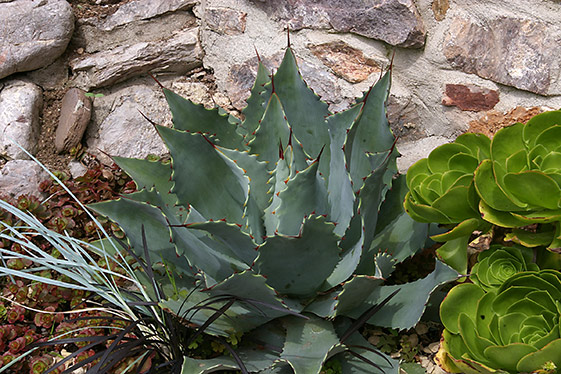 |
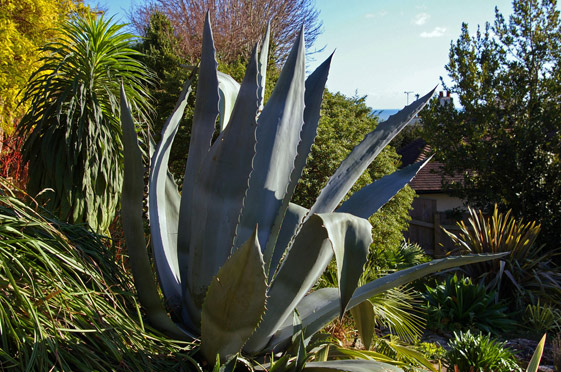 |
Agave
potatorum growing in a raised bed in very gritty soil at the foot of a south-facing
wall. The overall position is on a south-facing slope of some 30°
on average. This agave is not generally reliable outside and tends
to be attacked by rot during winter; I would not therefore recommend it for growing outside even in the South-West. The next-to-ideal conditions
provided here have ensured its successful over-wintering during worse
than average winters. To its right is Aeonium undulatum,
a comparatively tender aeonium which survived the 2010-2011 winter
(temperatures down to minus 4½°C in the open) with minimal damage. |
Agave americana growing on the south-facing slope behind the house. The appearance of the plant was probably at its best two or three years before flowering - later it began to look somewhat tired and weatherbeaten. The agave flowered in 2016 - about 20 years after planting. While this may seem a long time the amount of bulk put on by the plant during that time was huge and the diameter of the stem at the base was about 30 cms. The large leaves of this agave make it easy prey for high winds which cause the sharp teeth on the leaves to inflict self-damage on the plant especially during winter. |
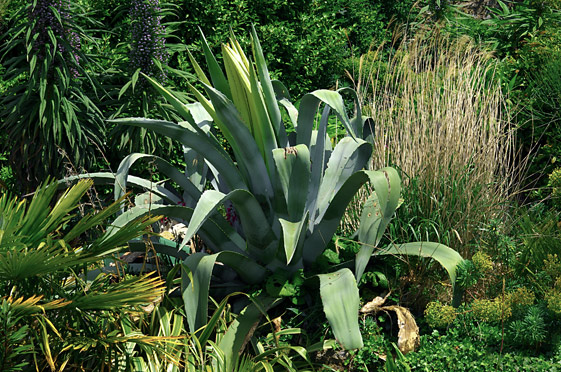 |
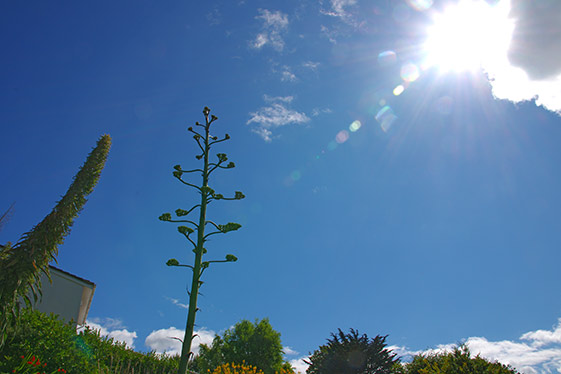 |
| The beginnings of a flower stem on an Agave americana. At this stage the foliage has lost much of its previous blue-grey and looks generally tired. The developing flower stem literally sucks the life out of the rest of the plant. | The monumental flower stem of an Agave americana. Within a couple of months of appearing the stem was over 8 metres in height. The effort put in by the plant is such that it cannot subsequently survive and gradually begins to rot away. In most cases a crop of offsets is left around the base of the plant. The tall plant on the left is an Echium pininana. |
***
Agaves are native to Central and North America. Most species grow in hot, arid conditions - these are the archetypical desert plants which, together with opuntias and saguaros form the southern wild west landscape of the United States. They are generally monocarpic (they die after flowering) and, despite being often referred to as 'Century Plants', live depending on conditions for 20-25 years (in the case of Agave americana). Whilst I enjoy seeing agaves flower I am always slightly agrieved by the fact that the impressive flower stem marks the end of the magnificent plant. Vicious spines at the tips of leaves and sharp teeth along the edge are typical (but the latter are by now means universal) and visible stems are absent (A. attentuata, A. victoriae-reginae and A. bracteosa are well-known exceptions in all respects but there are many others).
Agave americana is the one to grow if you want to grow just one specimen or species. It is also one of the largest (monstrous, in any case), perhaps the most impressive and the easiest. The glaucous leaves attract the attention of the eye - especially in bright sunlight. It is also considered to be very cold-resistent although Irish lists it as tolerant to merely -9°C2; but it is a well-known fact that the cold tolerance of individual plants varies considerably with their locality of origin. My large specimen spread to a diameter of about three metres and was over two metres tall before flowering after about 20 years since being planted out. There are some varieties which are considered to be particularly attractive: A. americana var. mediopicta 'Alba' - a small very attractive variety with a prominent white stripe down the middle of the leaf (I have found this variety to be painfully slow-growing; the 'ordinary' variety of mediopicta is much larger and has a yellow stripe. A. americana var. marginata is similar in size to the species and has a yellow edge to the leaf. I have found them all to be similarly hardy and take several degrees of frost provided they are not waterlogged. There is some doubt amongst botanists as to whether A. americana is a true species and whether or not the obscure-sounding A. franzosinii is a varient of it. This agave is even larger - eventually spreading to 4 metres with a leaf width of up to 35 cm. All these plants readily produce offsets from which they can be easily propagated.
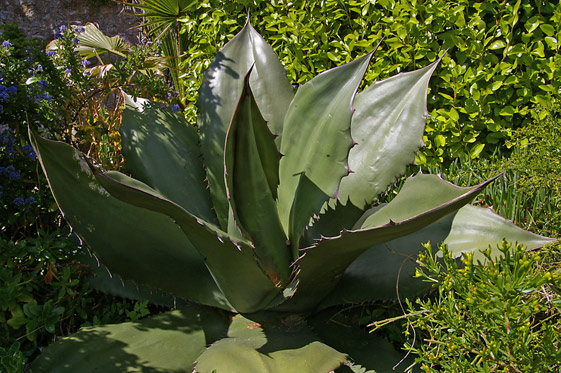 |
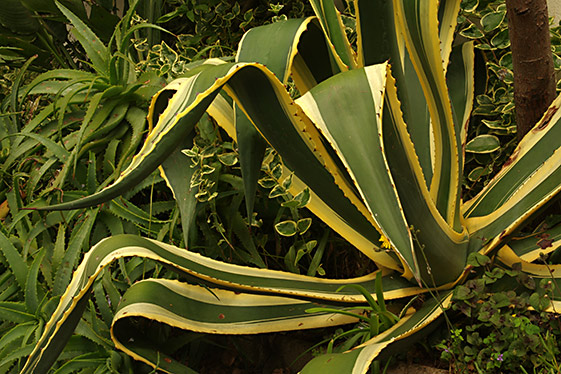 |
| Agave salmiana var. ferox (syn. A. ferox). This agave is one of my favourites: dark green leaves, exceptionally vicious-looking teeth and terminal spine, chunky and potent appearance. A. s. ferox is marginally less hardy than A. americana so particular attention needs to be paid to siting and soil. It produces offsets less readily which can be seen as an advantage; its silhouette is not spoiled by numerous juveniles vying for attention. | Agave salmiana angustifolia 'Variegata' - at least this is supposedly the name of this plant. This variety is noted for its wavy and often convoluted leaves. Any 'winter wear' is soon left behind by vigorous leaves during spring. It bears a greater resemblance to A. americana than it does to the A. salmiana basic species. |
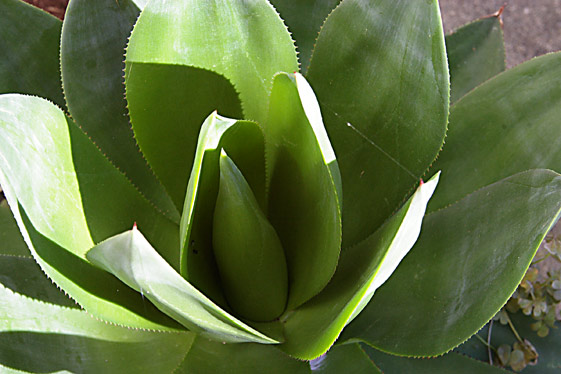 |
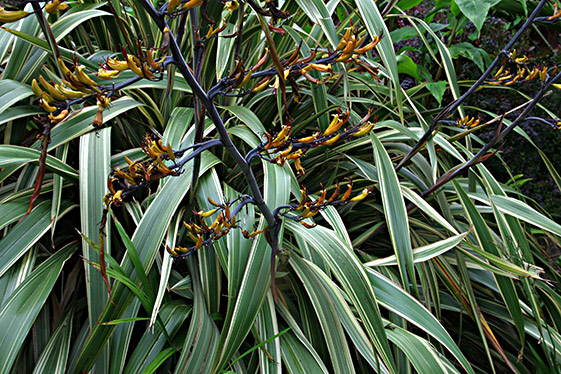 |
| Agave mitis (syn. A. celsii) is a medium sized agave which is native to rocky, damp and shady locations at higher elevations in Mexico. In my experience it has not been affected by the worst of the weather here in Torquay over the past 20 years. Its clustering habit has meant that the clump has flowered twice without any damage other than the demise of the spent rosette. | Phormium cookianum 'Tricolor' has lax, floppy leaves and is a very attractive variety. I include it in this group only because it was once considered to be a close Agave relative. It is smaller than the other also New Zealand species P. tenax. I find the smaller phormiums easier to manage. I will add here that 'small' is a relative term here - they are still very large. Our specimen has an overall spread of about 4 metres. |
***
Both the genus Agave and the family Agavaceae contain a variable number of species. By this I mean that over the years plants have been shunted in and out of them whilst botanists were making up their minds as to what characteristics to take into account when defining genus and family. Of course, this is a general feature of taxonomy only in this case gardeners and plantsmen generally find such indecision irritating and pedantic labellers begin to have nightmares. Nevertheless, suffice it to say that the number of species included here in the group 'Agaves and their Relatives' is not only very large but contains very many plants which can be grown in the South-West and even in the North.
In addition to the stock Agave americana I grow several distinct-looking species. A. salmiana and, in particular, its more robust-looking variety A. s. 'Ferox' is a favourite of mine. The species itself takes down to -15°C in its stride although in the case of 'Ferox' I have discovered that it requires very well-drained soil at low temperatures. Otherwise it is prone to root loss. A. salmiana has another variety which is often confused with A. America but A. s. angustifolia 'marginata' (or perhaps 'variegata') has long wavy leaves. They tend to flap around a bit during winter and become disfigured; I cut the offending ones off (do not use anything but a sharp knife to cut agave leaves) in the spring and the plant soon makes up the losses. This variety is slightly less hardy.
Agave mitis (syn. A. celsii) is one of several exceptions to the rule of sun, heat and dryness. It grows in rocky, damp, shady areas and seems to be unaffected (so far) by moderate winter damp. It is said to be resistant to cold down to minus 7-8°C. Perhaps an ideal agave for our British climate; even up north it could be propped up against a wall to overwinter and the chances are it will. It is also exceptional in that its closely-packed teeth and weak terminal spine are relatively harmless. I normally 'service' it without gloves and the worst I have received in return is a slight scratch. This is not all. Agave mitis, in contrast to other agaves which produce offsets by means of underground shoots or runners produces offsets directly off the base of the stem. This has the advantage of allowing the whole clump to avoid 'death by flowering' whilst producing a somewhat untidy mound over a period of time. Special attention must be paid to snails - they seem to prefer this agave to most of the others.
Another agave which is gardener-friendly is the spineless and toothless Agave bracteosa (Spider Agave). Like A. mitis it grows on damp shady rocks in Mexico and is more hardy (down to -13°C). I planted mine a few years ago on an vertical limestone (it naturally grows on limestone) 'cliff' where receives practically no sunlight - even in summer. It is definitely a slow grower but I have not noticed any damage, even from slugs.
Some years ago Nick Macer from Pan-global Plants in Gloucestershire sold me an Agave Montana which he told me was a recent discovery. He also mentioned that the species varies considerably in hardiness. His clone has proved to be absolutely hardy here and the species is generally thought to be one of the hardiest agaves. Its leaves are unyielding and the terminal spines poised. Agave montana does not produce offsets which means that its silhouette is tidy; it is a very slow-growing species which could also be an advantage if we do not want it to outgrow its welcome. To grow well, however, it requires a soil rich in organic matter. I have it growing in a pot and can say that it has not grown much in the 15 or so years I have been waiting to plant it out.
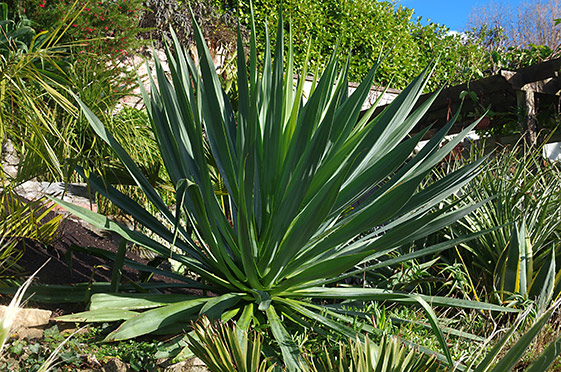 |
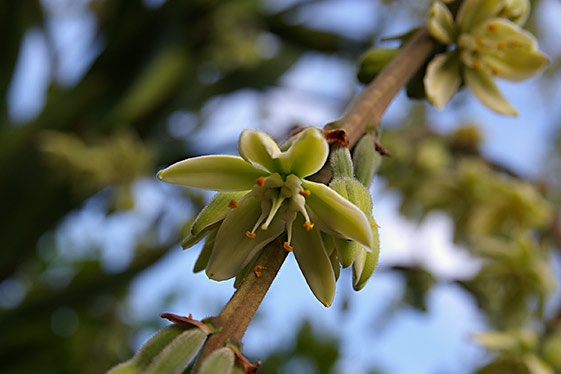 |
| The agave-like Furcraea longaeva (Giant Furcraea) growing on a sunny south-facing bank at Southern Comfort. This plant is about seven years old and is approaching flowering size. | The lime-green flowers of Furcraea longaeva have the texture of felt. The flower stem of this plant can be several metres high and is easily mistaken for an Agave flower stem. The plant dies after flowering. |
***
One agave which I would hesitate recommending, although it is very hardy and resistant to moisture, is Agave utahensis. I say this because I have never seen an attractive specimen apart from on photographs. They seem to become lopsided and lack the character I associate with an agave. A friend in my locality had a specimen growing for many years in clayey soil in a relatively exposed garden on a hilltop in Torquay. Quite suddenly, the plant died before flowering but I suspect that it had suffered a good deal of mechanical damage from careless garden contractors. However, this is one of the hardiest of the agaves - it takes lows of down to minus 23°C!2 Try it anywhere but do not forget the well-drained soil and the sun. Other exceptionally hardy agaves are A. havardiana (minus 23°C), A. neomexicana and A. parryi (both minus 29°C)2; I have very little experience of these although I have lost some A. parryi outside (yes!) due to winter rot. I suspect the plats may have been too small and the soil not gritty enough.
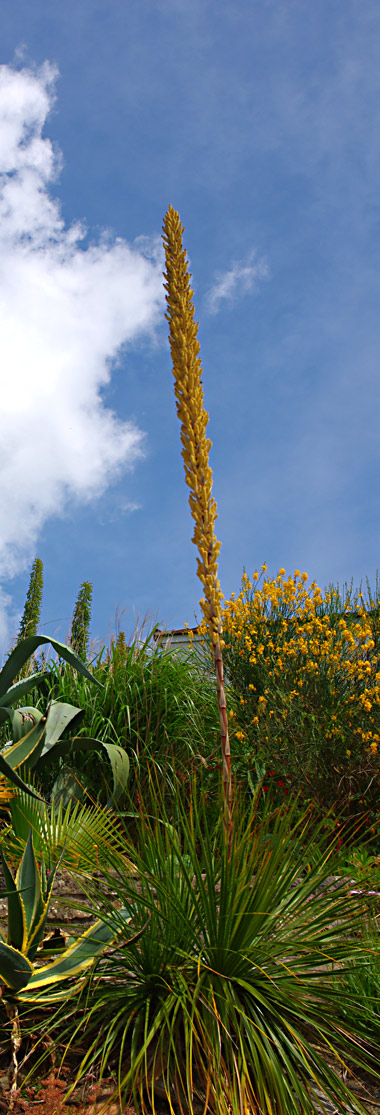 |
| Dasylirion texanum in flower, July 2015. |
Of the plants once included in the Agavaceae (the agave family) perhaps Phormium and Yucca are the best known. Their claim to being members of the succulent group is not immediately obvious and, like the others which I mention below, is limited to stems or the bases of trunks. In the case of Phormium it is the rhizomes which are the fleshy part and, in ant case, phormiums do not grow in areas where rainfall is lacking. Nevertheless they make a striking addition to in an exotic garden provided they are well maintained. This is often a problem. Phormium grows in such a way that the dead leaves soon begin to radiate out horizontally from the base of the plant. Occasionally, rhizomes begin to emerge from the soil and weaken the plant’s anchorage with the result that bits of toppled plant add to the débris. The solution to the latter is to plant the phormium solidly below soil level (not like irises) and to keep an eye on the base of the plant during the growing season and take any remedial action that may be necessary. Tidying up the dead leaves is a bit of a chore; the best, and I believe the only, way to do it is to pull the leaves – cutting them close to the base will leave an unsightly crop of stubble around the plant. The best way to pull them is to take a small section of an old broom handle and wrap the leaf around the hadle several time. This enables the pulling to be an easy two-handed job – if pulled at the correct angle they come away without too much difficulty.
The yucca which impresses me more than any other is Yucca elephantipes (syn. Yucca guatemalensis). This yucca, although it grows to several metres in height, is generally considered to be an indoor plant. Its singular feature the substantial base to its trunk from which, in time, dozens of trunks will grow. Although it will take only a few degrees of frost it manages to overwinter successfully here at Southern Comfort. A distinctly tropical and exotic-looking plant and I recommend it strongly for and exotic garden. It is easily propagated from stem cuttings.
Some species of Furcaea can be easily mistaken for agaves. Indeed, Furcaea longaeva is a good substitute which has all the advantages of the agave with none of the disadvantages except that, like the Yucca elephantipes above, it will take only a few degrees of frost. F. longaeva is a large plant – its sword-shaped leaves hide its stem and spread to 2-3 metres; it requires a sunny position. Its leaves are soft and pliable, it has no teeth or terminal spine, it does not produce offsets, its spectacular agave-like flower spike appears in only a few years and bears not only seeds but also plantlets in the vicinity of the seed pods. They can be planted out the following year.
When not in flower Dasylirion texanum could be mistaken for a bromeliad. Even at close quarters the leaves are more bromeliad-like than agave-like. In my experience when growing in full sun this small to medium robust xerophyte will take a little dampness and low temperatures in winter (down to -15°C2) and, when mature and conditions permit, will produce 2-2½ metre flower spikes each year. Whilst not impressively tall the spikes nevertheless are in proportion with the size of the plant and add much character to an area of succulents. Every few years the dead leaves can be pulled off for the sake of appearance. The toothed leaves are not over vicious but care still needs to be taken and leather gardening gloves worn.
Beschorneria yuccoides and B. septentrionalis are not as hardy (to -9°C2) but once seen in flower never forgotten. Indeed when not in flower they are hardly noticeable apart, perhaps, on account of their size (clumps easily spread to 1.5 metres) and their slightly untidy, floppy leaves which, if inspected closely, are often savaged by snails in gardens where slug bait is forbidden. It is only when Beschorneria begins to show a flower spike that it becomes impossible to miss. The stem generally grows out at an angle which is a very good reason for planting it on a slope or a terrace edge. The plant suddenly begins to take on a zoological, almost reptilian, appearance which might even scare the wits out of somebody if it suddenly appeared through their window. It grows rapidly and changes character as it grows although at the final stages
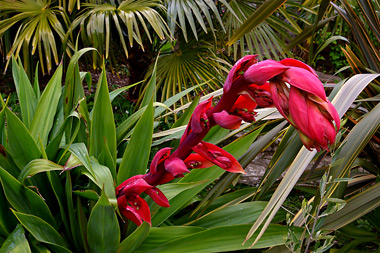 |
| This is Beschorneria septentrionalis probably at its best. The crimson red colour contrasts excellently with the rich green of the leaves. The stem soon becomes leggy and lacks the provocative demeanour of the undeveloped buds. |
These two species of Beschorneria are fairly similar - possibly too similar to make growing both of them together worthwhile. B. yuccoides has, in my view, the better foliage: the leaves are held more elegantly and have a slight silvery glaucous edge to their colour but their flowers lack that little extra boost of red which B. septentrionalis offers. Take your choice - both are very good plants for the warmer U.K. garden and look very tropical.
The description by Irish2 intrigued me enough to want to try out at least one species of the unusual and unheard of by some Manfreda. A variety of common names have been applied to plants in this genus: Spice Lily, False Agave, Rattlesnake Master, American Aloe, Mottled Tuberose, Texas Tuberose, Huaco, Amole. I obtained a plant or two from Bob Brown (Cotswold Garden Flowers) six years ago in 2012. They were sold as Manfreda variegata. According to Irish M. variegata is a cover name given to 'a host of different-looking plants' and give -9°C as its hardiness limit. My plant is pleasant enough, has soft, semi-deciduous maroon mottled leaves and has spread moderately over the years. Some offsets were left potted, others were planted out. It has never flowered. A general search in books and on www pages would suggest that it might be M. maculosa on account of the maroon spots on the upper surface of the leaves. I can see that a large clump of Manfreda in flower would be an asset amongst my succulents; I am not therefore giving up on it just yet.
More in terms of a footnote to this section I would like to humour the more pedantic and, firstly, correct my statement about the Agavaceae. In keeping with the general feeling amongst gardeners I am mourning the demise of this family. It no longer exists and the plants from it have been dumped wholesale in the new sub-family (not even a family) Agavoideae.
This brings me onto the second point which concerns Cordyline a one time member of the Agavaceae. This plant is otherwise correctly know as the New Zealand Cabbage Tree - an undistinguished name - and incorrectly as a Torbay Palm - a more distinguished name and one which would make the owner of such a plant quite proud. But the name is most misleading because the Cordyline is related to the agaves and yuccas - the resemblance to a yucca is not short of obvious. Whilst we have numerous Cabbage Trees at Southern Comfort they are too common to make any remarks worthwhile. And, in any case, including them amongst succulents must be pushing the notion a bit.
However, there are two which I consider to be very deserving: Cordyline indivisa (Blue Dracaena) and Cordyline kaspar (Three Kings Cabbage Tree). As its name suggests C. indivisa from New Zealand has an unbranched trunk and exudes exoticism. It is difficult to grow and specimens are often lost after having grown well for a few seasons. Reputedly quite frost resistant (to -10°C) when mature. Sadly, I have lost a few in recent years and soon gave up trying. C. kaspar is like an exuberant but smaller version of C. australis and, as such, is more tropical-looking. It was always described as native to Three Kings Island, which it is, but now it seems that it is also native to other small island off the north coast of New Zealand and to part of the mainland itself. Kaspar, as we all know, was one of the Three Kings who visited the newly-born Jesus in the stable. Now to add insult to injury we can read in Wikipedia that it has been renamed C. obtecta - 'kaspar' was more evocative. I have been growing a purple-leaved variety of C. kaspar for about ten years under a leaf canopy. I have found it rather slow-growing - about one half to a third the rate of the species C. australis - and it is yet to branch. The standard green form may be faster. However, I find the purple foliage makes an excellent contribution to an otherwise all-green exotic corner ('the rainforest).
Aloe
The best known member of the genus Aloe is Aloe vera - a plant so widespread that botanists are undecided as to where it originates from. Africa or Arabia have been suggested by some authorities - this is hardly a remarkable statement since all aloes are native to Africa or Arabia (including Madagascar and some islands in the Indian Ocean). I do not consider A. vera to be a good garden plant - I do not even consider it to be a good house plant. It is best grown in a conservatory or, better still, in a heated greenhouse. Despite this it remains popular with the public. But is neither hardy nor is it resistant to rot. All the aloes we grow at Southern Comfort are native to South Africa - species which are not are probably too tender to grow in this country but I have no experience of them.
Botanists were originally happy to place the genus Aloe in the family Liliaceae - the lily family. Later, they were transplanted into the Asphodelaceae. Still a respectable-sounding family. However, the development of DNA sequencing and other advanced techniques instead if simplifying matters have shunted them into a quite horrific-sounding tribe - the Xanthorrhoeaceae. If past experience is anything to go by they will soon be damned to something even worse.
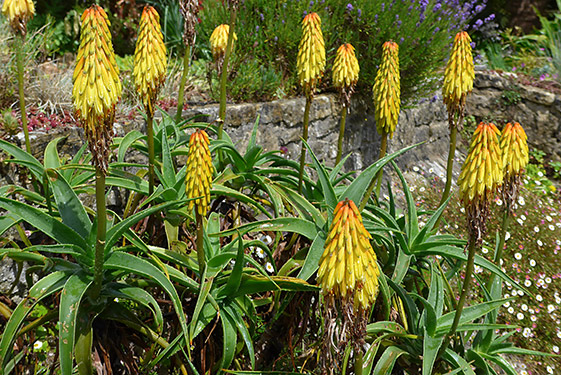 |
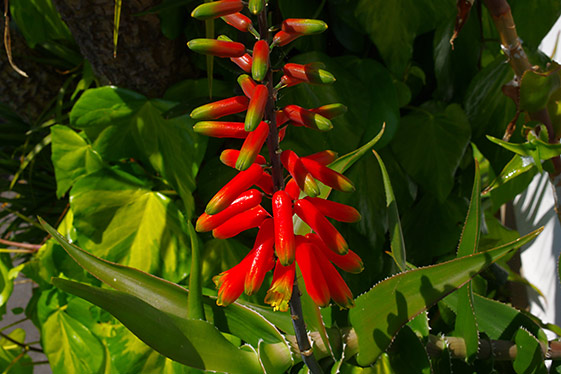 |
| A small bush of Aloe striatula in July. A warm sunny position brings out the best in all aloes. The daisy-like plant in the background is Erigeron karvinskianus (Mexican Daisy) which is an excellent companion for larger succulents. Hugh Latimer (The Mediterranean Gardener, 1990) recommends it and once wrote that 'it has the constitution of a donkey'. He probably meant that it is most resistant in all respects. | Aloe ciliaris flowers throughout the year. Despite overall similarities of this species with A. striatula the flowers of this species are quite different. A. ciliaris is extremely vigorous and can grow to a height of 2 metres in very little time. Here it is growing by a Cordyline australis trunk with the large-leaved ivy Hedera colchica 'Paddy's Pride' in the background. This ivy is perhaps the most exotic-looking ivy generally available. |
***
There is probably only one species of Aloe which can be thought of as solidly hardy in the South-West: this is A. striatula. But even here I have seen a sizable bush, 1½ metre high and with a spread of 2 metres, cut down to almost ground level during one of the recent severe winters. The plant was growing in a neighbour's garden 100 metres above sea level; the temperature dropped to probably below -8°C, which is probably the plant's limit. Brian Kemble's in his List of Hardy Aloes3 gives A. striatula's minimum temperature in cultivation as 18°F (=-8°C). A. striatula is undoubtedly a good plant - in addition to its high level of hardiness and exotic appearance it is easy to propagate (stems root very readily), if you obtain good strain it flowers well and dependably, it is not particularly fussy about position although it flowers best in full sun. In terms of temperature alone it does not seem to be exceptionally hardy but it probably makes up for this by being fairly resistent to winter damp.
Most, if not all, the Aloe species are prone to different degrees of slug and snail damage and A. striatula is no exception. Slugs and snails will have anything they can get their rasping tongues on: leaves, flowers, roots and even parts of the shoot. The usual precautions must be taken with some additional vigilance - aloes are worked on at high speed.
Aloe striatula requires little in terms of servicing apart from cutting down the dead flower stalks unless seeds are required. Some gardeners also like to remove the dead leaves - once fully dried they come away from the stem easily enough but, if left, they simply drop off after a couple of years. I tend to leave them on. When the plant is small it is difficult to imagine the size to which it will eventually grow - arching stems soon root when they touch the ground with the result that the 1½-2 metre high shrub begins to spread indefinitely (until and unless the <-8°C comes again). Even then, it soon regrows from the root. The ease of rooting exhibited by this plant also means that it can be constantly redistributed around the garden according to whim and initial siting becomes of less of an issue. Most strains of Aloe striatula become leggy over the years with the stems rarely, if ever, branching. Depending on the sort of effect you require you can confidently cut the stems down to within a few inches off the ground. Each stem will then produce several shoots all of which will rapidly grow into a compact bush. A. striatula is one of a minority of Aloe species that flower in the spring rather than in mid-winter.
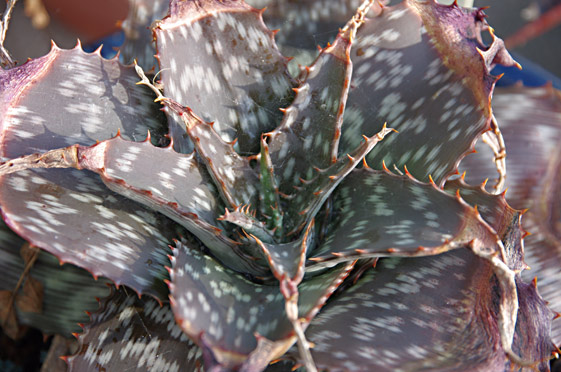 |
| Aloe zebrina 'grown hard' in pot exhibits the typical dried and twisted leaf tips. Often it appears as though most of the leaf has become affected. This species is not one to be planted out in the garden - unless you want to lose it. |
The remaining aloes I describe and recommend must all be approached in the spirit of experimentation for they can easily get walloped even during our mild south-western winter. Well-drained soil with generous grit, full sun, south-facing slopes, débris removal during winter, no overhanging trees, shrubs or other plants, slug and snail-free zone - all these conditions will improve chances of success and may even delude one into thinking that these plants are easy to grow. Speaking for myself I can say that I enjoy the delusion.
When still small, Aloe ciliaris resembles A. striatula. It is only when it begins to grow and flower that it becomes clear that it is a climber or rather a scrambler which grows very rapidly whilst pushing is stems against any support they can find. In a garden, of course, it needs a little help. At Southern Comfort, a plant producing multiple stems reached a height of about 3 metres in as many years having been secured to a Cordyline australis and some balcony railings all against the south wall of the house. The speed of growth was remarkable although it has since slowed down considerably4. Once it begins to flower it does so non-stop throughout the year. Our strain is very floriferous and atthe time of writing (January 2018) it has a full dozen of healthy-looking inflorescences. A. ciliaris's Latin name comes from the hairs on the edges of its leaves - especially prominent near the base of the leaf. The bases of the leaves clasp the stem entirely unlike those of A. striatula which are attached on one side of the stem only. Like A. striatula it is easy to propagate from stem cuttings. This plant has grown happily at temperatures no lower than minus 2-1½°C - in Brian Kemble's table its minimum is given as minus 6½°C. The 2018 mid-March cold spell did no favours to my form of A. ciliaris. Despite the closeness of the house and a lowest temperature of possibly minus 3°C almost all the top growth became frosted. The plant soon recovered but will take a couple of years to regain its original size.
Aloes are often grouped by specialists in different ways in order to facilitate descriptions and identification. One such group is the spotted aloes. Overall an attractive group but the leaves all have sharp teeth while in many species the tips of the leaves soon dry, curl and harden to form nasty jagged hooks which need to be treated with respect. In this group there are a few species which I have found to tolerant of several degrees of frost. I have had A. maculata (syn. saponaria) growing for some years in various part of the garden - some in locations where the important conditions required for successful over-wintering were very obviously unsatisfied - and have had little or no winter damage and certainly no losses. Tolerant to -7°C, says Kemble, and 'quite hardy and does not mind winter rain'3; my experience confirms this. This is not a fully reliable flowerer but in a group some plants at least will flower; it has the advantage of less curling of leaf tips than other species and its teeth are rather less aggressive. The strain I have flowers in the summer and a reasonable amount of offsets make propagation easy if not over-rapid. I have been promised a fast-growing clone of this species and, if it grows expected, I will add some further comments at some stage4.
The other species of spotted aloes which have so far been successful here are A. longibracteata, A. grandidentata and A. greatheadii. I have run them together because firstly, they are very similar (difficult to distinguish even by specialists) and secondly, there is some doubt as to whether they are distinct species, hybrids or naturally occurring varieties. From our immediate point of view it is their resistence to cold and damp that matters and in this respect they are all similar. A. grandidentata would appear almost indestructible here - minus 12°C according to van Wyk & Smith5 but Kemble3 gives only -7°C; A. longibracteata is given a less optimistic -5°C5. These three species offset moderately and, in this garden at least, I have not yet had winter losses other than only a few stemming from gross neglect. These aloes may not be that easy to find and are sometimes mislabelled by nurserymen; however, they are all most certainly worth a punt.
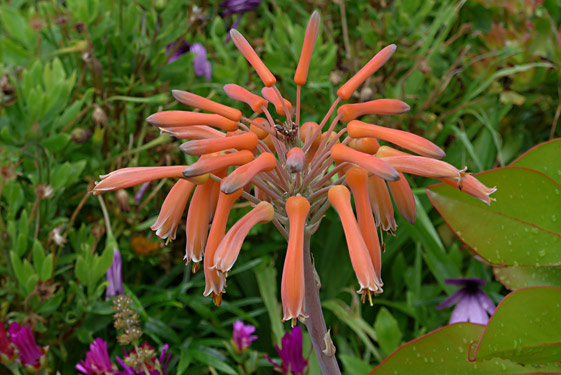 |
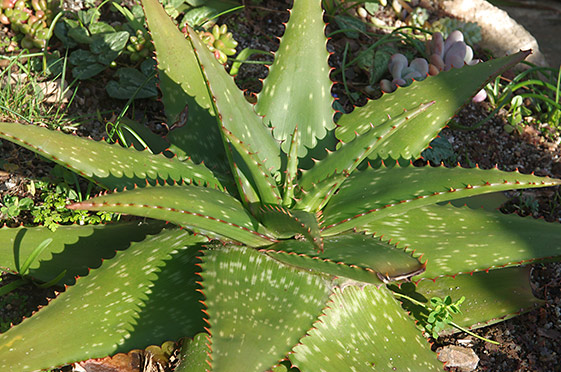 |
| Aloe maculata flowers - it is characteristic that they form a rather flattish raceme. I have found it a relatively easy plant to grow and if you want to grow spotted aloes this is the one to try first. | The spotted Aloe longibracteata in midwinter. The plant looks surprisingly fresh and the leaves are swollen and hard as a result of exceptional rainfall. Spotted aloes, when given rich soil and fair moisture maintain their leaf tips much longer that those 'grown hard' with less moisture in pots. Such plants are, of course, more at risk during winter. This plant has been growing in a pot outside for several years and this is its first winter in the ground. |
***
Next are the small (dwarf) clump-forming aloes: A. brevifolia, A. aristata, A. humilis and A. variegata. They are all frost resistant to about minus 7°C6. They are all also excellent pot plants and will flower and clumps spread steadily to fill a pot to well beyond overflow level. It is at this point that They are at their most attractive.
At Southern Comfort I have grown all except A. variegata outside for over 15 years and have found them resistant to the lowest temperatures we have had. However, I have lost several small clumps of A. aristata at temperatures well above those which the plant had previously happily over-wintered; a friend of mine once lost whole bank of several hundred plants during one not so cold winter. The cause is probably excessive damp and subsequent damage due to moulds and rots. This species must have very well-drained soil and good air circulation. The other species which requires very well-drained soil is A. variegata. Although this is a winter-growing it dislikes winter damp and, according to my experience, it is not keen on too much summer watering either. It is a very attractive plant and grows well in pots provided its roots do not remaining in permanent contact with water or damp soil.
Aloe brevifolia is native to Cape Province which is a high winter rainfall area. Not surprisingly it will put up with damp soil during winter and will look fresh and healthy during this season. I have some clumps growing on a vertical wall in full sun and I occasionally lose a rosette generally during autumn. This may be due to excessive summer damp which they dislike. I lost a pot-full one summer due to over-watering.
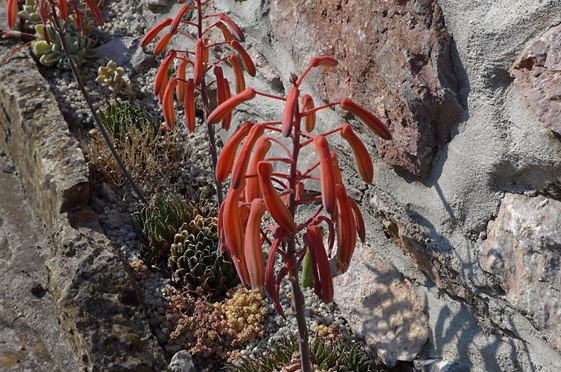 |
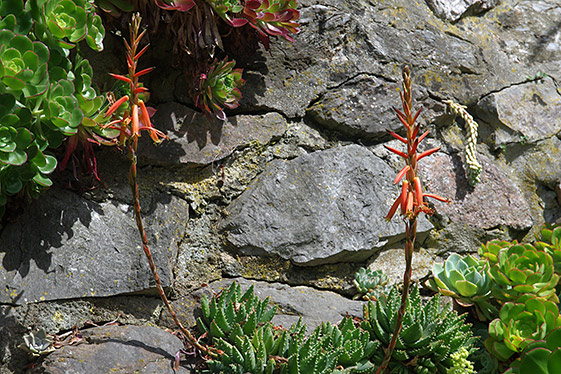 |
| Aloe aristata belongs to the small or dwarf aloes. It will take several degrees of frost (-7°C according to Kemble3) but I have seen very large clumps rotting at temperatures above zero when subject to winter damp. The leaves of this species look best when it is growing in rich soil with adequate moisure. It is precisely under these conditions that the plant is most at risk from mould and rot atttack; to grow A. aristata successfully you have to put up with unattractive, curled up and dry-looking leaves. | One of several clumps of Aloe brevifolia growing in the side of a wall. As the clump spreads the roots find their way into every possible crevice with the result that the plant becomes very firmly attached. Such an arrangement also ensures next to perfect drainage and ideal air circulation. |
***
Aloe humilis has leaves covered with harmless prickles and has probably the most attractive flowers of the four species. They appear slightly over-sized for such a small plant. I have obtained this plant from a few different sources and each batch appears slightly different; I have grown (one 'variety' of) this species successfully for many years in a similar situation to A. brevifolia. I cannot help noticing that snails also find the flowers of A. humilis very attractive. Whilst they never 'have a go' at the leaves they come in droves as soon as the flowers are about to open; these are generally quickly devoured. Very often a snail is so impatient that it rasps its way though the stem before even reaching the flowers. Whatever I do, I always lose a few flowers each year.
In addition to Aloe striatula, the two species - A. arborescens and the somewhat similar A. mutabilis - belong to the shrub or multi-stemmed aloe group. A. arborescens is the larger of the two and I tend to look at it more as a foliage plant - my clone, at least, is not a prolific flowerer and tends to flower better with some root constriction as in a pot. If the foliage can be kept undamaged it is a most impressive plant with a slight glaucous bloom to the leaves and which will occasionally reward with some flowers in January and February. This species grows naturally in the east coast of South Africa as far south as the high winter rainfall area of Cape Province; this immediately suggests an adaptable species and one that may take some winter damp. I have found it to be fairly resistant to moulds and rots during winter but below about -5°C the leaves suddenly begin to suffer and are soon lost. Such a plant will re-grow from the base unless the ground freezes solid. The related A. mutabilis (often considered to be a variety of A. arborescens) is like a low-growing A. arborescens with leaves looking a bit 'spidery' in comparison. It is often also considered to be hardier but it is slower-growing and a more prolific flowerer. I have grown it for some years outside - both in a pot and in the ground - and have not (yet!) noticed any winter damage. Both these species are good plants for the milder garden.
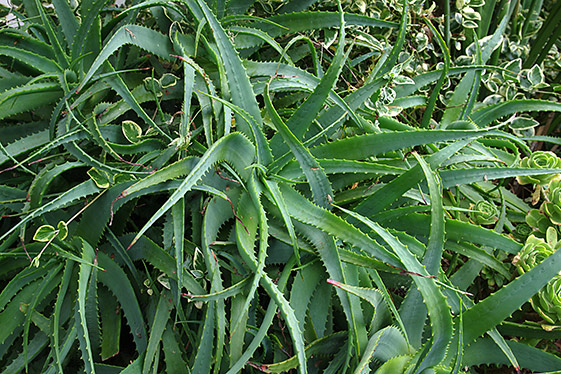 |
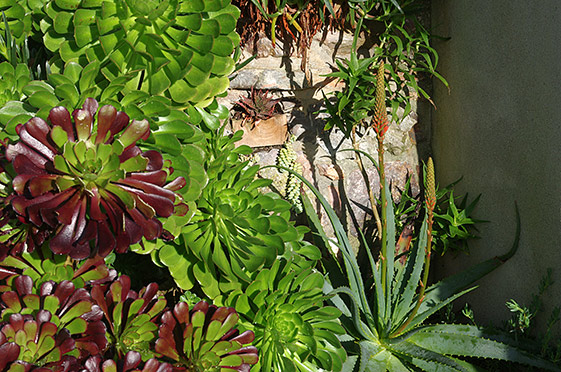 |
| The shrublike Aloe arborescens has superb foliage and in time will grow (in the South-West U.K.) to 1½ metres and spread to maybe twice that. At least this is what it does at Southern Comfort. In its native habitat in South Africa it will grow to 2 metres or more. Here it is growing against the south-facing wall of the house. | Aloe mutabilis in January growing in the company of aeoniums and other succulents against a south-facing retaining wall. The developing flower buds will be fully open in February. A. mutabilis is related to A. arborescens which it closely resembles; however, it is marginally hardier and does not develop much of a stem. |
***
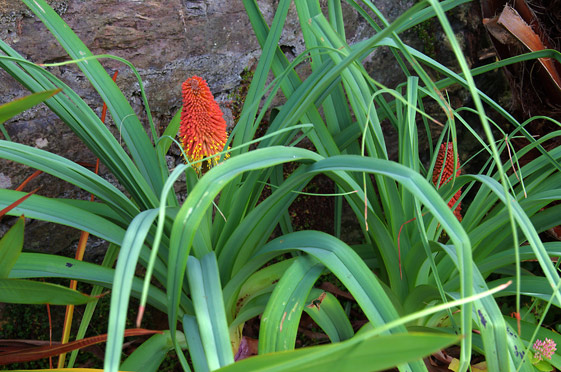 |
| Kniphofia calescens growing at the foot of a south-facing stone wall. This plant is best grown for its elegant foliage; it is not a reliable flowerer. |
The flowers of the Aloe species betray the close relationship of this genus with Kniphofia, the red-hot poker or torch lily. Kniphofia which, like the vast majoity of aloes is native to Africa, differs from them insofar as it does not posses succulent leaves and is happy in damper soil. Most Kniphofia species are hardy in the U.K. although in colder areas some winter protection may be required. There is one species of Kniphofia which is very much at home in the company of aloes - this is K. caulescens. It can even be grown as an Aloe subsitute in situations where aloes cannot be grown. From a not too great a distance K. caulescens can easily be mistaken for an aloe: its blue-grey leaves are arranged in a rosette and held in an upright and well-defined manner, its thick succulent stems creep along the soil surface rooting as they go, its flowers are more aloe-like than other kniphofias. Overall, it is a very attractive and distinctive plant in terms of both foliage and flowers. It is not without its faults, however. It is comparatively slow-growing and slow to branch, it can be shy to flower and dead leaves need to be removed regularly in order to prevent it looking unkempt.
At Southern Comfort K. caulescens flowers in September which is a welcome time but unfortunately the flowers are not long-lasting. Its foliage more than makes up for this. The late Christopher Lloyd who considered its foliage outstanding was not unduly concerned by this disadvantage calling the flowers 'a pleasing but inessential condiment'. To err on the safe side with K. caulescens it is best to plant it in well-drained soil.
***
Cacti
The number of cacti which can be grown outside in the U.K. is surprisingly large7. At Southern Comfort we have only a very limited number of species in the garden and my experience of cacti is similarly limited. The terrestrial ones we grow are tolerant of a degree of dampness - always a desirable feature in our climate and the two species of epiphytic cacti are, like all epiphytes, happy to take soakings even for prologed periods. Although cacti have interesting sculptural forms and stunningly beautiful flowers they do have a few significant disadvantages: slow growth (apart from some oputias), spiny exteriors, very short-lived flowers. Many are also too small to co-exist with the general character of the the planting we have. All cacti are native to the Americas where they grow in a variety of habitats ranging from hot desert to dry rocky outcrops and grasslands in the cooler extremes of their range. Cacti also grow as epiphytes where they experience lower levels of light and higher humidity than their terrestrial relatives.
Echinopsis oxygona is a cactus I have been growing outside for some years - Easter Lily Cactus is one of its common names. Latin cactus names are generally a minefield with name changes more common than garden weeds all resulting in frustrated, disoriented and confused cactus enthusiasts. In the case of E. oxygona the situation is probably typical: we can find it under just a few other names - Cereus multiplex, Echinopsis eyriesii, Echinopsis multiplex, Echinocactus oxygonus, Echinopsis paraguayensis, Echinopsis adolfofriedrichii, Echinopsis brasiliensis, Echinopsis derenbergii, Echinopsis tubiflora. E. huascha, on the other hand, has some 30 synonyms list on one internet page I saw. I daresay the peculiar taxonomy of cacti may be yet another reason why some people avoid them.
The Easter Lily Cactus is native to Argentina, Uruguay, Paraguay and Brazil. Provided it is growing in well-drained soil, has some sun (full sun is best) and has good air circulation around it especially during the winter months it will flower during late spring (already when 6-7 cms in height), offset and grow at a steady pace. It is reputedly hardy to about minus 10°C. The form we have is very floriferous with one plant (including offsets) producing as many as 20-30 flowers during one season. Each flower lasts a maximum of two days but often only one. The main plant is surrounded by numerous offsets thereby creating a mound and eventually reaches a height of about 40 cm. Our plants are about half that height. In the U.K. garden this plant never needs watering - indeed, despite being able to take some damp, over-watering is its main enemy.
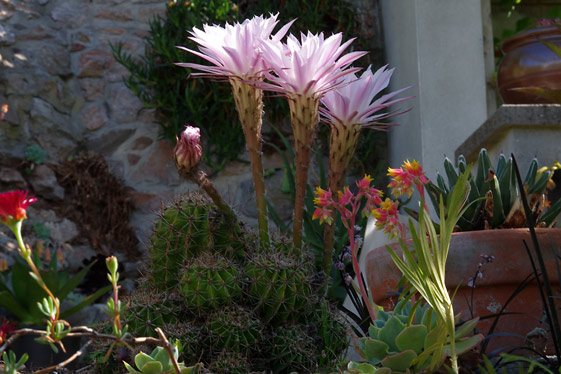 |
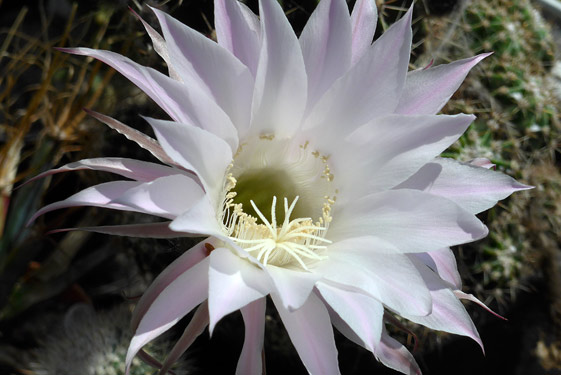 |
| Echinopsis oxygona growing in a sheltered south-facing area of the garden in the company of other succulents. Many buds flower in rapid succession often more than one at a time. The flowers are mildly scented each never lasting longer than two days. | A close-up view of an Echinopsis oxygona flower. As with many cacti the flowers appear to be disproportionatly large compared to the plant itself. This cactus is an ideal 'first cactus' to try out in a succulent garden. Otherwise it makes an excellent pot plant. |
Opuntias have a bad name and this is not undeserved. The shrub-like Opuntia stricta was at one time the number 1 weed in Australia having invaded many millions of acres of land and making it unfarmable. I never managed to identify the species we have growing at Southern Comfort but as far as I can make out it bears a strong resemblance to the pictures of Opuntia stricta which I have seen. Fortunately, even though O. stricta is hardy to minus 18°C (given the right soil conditions) it has never been able to gain a foothold as a weed in the U.K..
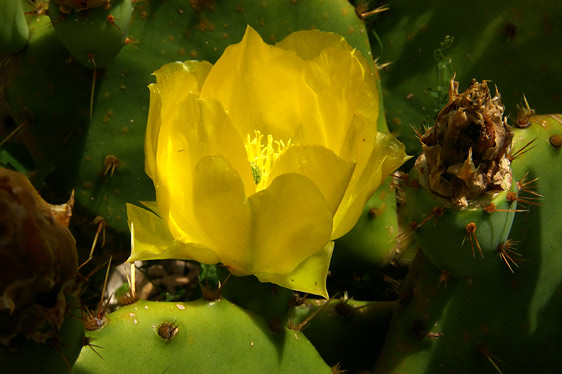 |
| An opuntia flower in the evening light. These extremely beautiful flowers remain yellow only for a day changing to a rather unexciting orange colour on the second. Finally the flowers drop leaving the developing fruit (seen here on the right of the flower) which ripens to produce a tastey edible but seed-ridden pulp. Take care to remove all glochids before attempting to open or eat the fruit. |
Our opuntias produce a very large number of flowers in succession over a period of a few weeks - generally towards the end of spring and the beginning of summer (see picture at the top of this page). Seen in full flower this plant cannot but impress. It has bright green pads, an almost labyrinthine form, cruel-looking spines but the most delicate-looking flowers imaginable. Looking at its flowers it is easy to forgive its sins.
It is not an easy plant to manage. The first and most obvious problem is its aggressive spines although there are some spineless forms. The spines are exceedingly sharp and will penetrate the most resistant protective ware. If they break or detatch themselves from the plant they can gradually work their way into clothing until they reach the skin. They do this because they are covered in minute backward-pointing scales that act in a similar way to barbs. If they enter the skin and then break off we can be sure that this will cause trouble. However, this is only a starter.
The real danger comes from the glochids - very tiny but tough spines covered in a multitude of very effective barbs. Glochids are unique to opuntias and are to be found in tufts at the base of the spines. They are present even in the unspined forms such as O. microdasys (the innocently-named Bunny Ears) or O. basilaris (Beaver Tail). They are thinner than human hairs which makes them almost invisible to the naked eye except in excellent light. Detatching themselves from the cactus with almost no provocation they immediately imbed themselves in the skin and soon begin to cause extreme irritation unless removed. Very serious dermatological conditions may result from embedded glochids. Because I always keep a watchmakers' eyeglass and a pair of tweezers handy when working with opuntias I am able to deal with the vast majority of problems immediately and strongly advise all opuntia enthusiasts to do likewise. When an area of skin becomes excessively covered in glochids adhesive tape used decisively will remove the vast majority. Extreme cases may require specialised surgical intervention - so be warned.
The above features present the gardner with problems weeding among clumps of opuntias and also when transplanting and propagating from the pads. I find that a hoe or a similar tool on a long handle is suitable on most occasions and to handle the plants, as well as protective leather gloves, I use a length of folded or rolled up newspaper which, for obvious reasons, is quickly and carefully discarded immediately after use. These measures are useful even when managing less vicious cacti.
Despite the above difficulties I find the large opuntias rewarding to grow in the garden. They are less suitable as pot plants where their spines and glochids would present a constant menace. In the company of agaves, other species of cactus, large rocks and a generous top dressing of grit they can create a credible 'wild west' desert area. As well as keeping the ground surface dry the grit also makes the removal of weeds easier. Propagation is easy: pads (or parts of pads) root easily and grow into identical clones; otherwise seeds from the fruits can be used to sow a more variable population - this takes longer and requires more care.
Quite different in almost every way are the cacti from what I call the Epiphyllum group. There are many varieties and hybrids within this genus and the closely related genus Disocactus. I do not have the expertise distinguish between these cacti and I will simply refer to them all as Epiphyllum. Epiphyllum is a cactus with long flattened stems with large serrations or lobes on the edges; occasionally the stems are triangular in cross section. They flower profusely in shades of white, cream, pink, orange, red and sacrlet during winter and early spring with the blooms often lasting for several days. All Epiphyllum are reputed to be tender with very little or no resitence to frost. The form I have been growing outside for some years is an intense deep carmine-red with long-lasting blooms. The plant survives very well from ground level and to about 30 cm. but I have not managed so far to get it up any higher - it is the top growth which is most at risk during winter. Lower down the plant seems to take a few degrees of frost in its stride (during the 2018 mid-March cold spell it remained intact). I have found that it flowers well both in sun and in light to medium shade although it possibly produces more flowers in the sun. There have been times when this plant has surprised me by flowering in a location where I had placed it some years previously and then forgotten about it.
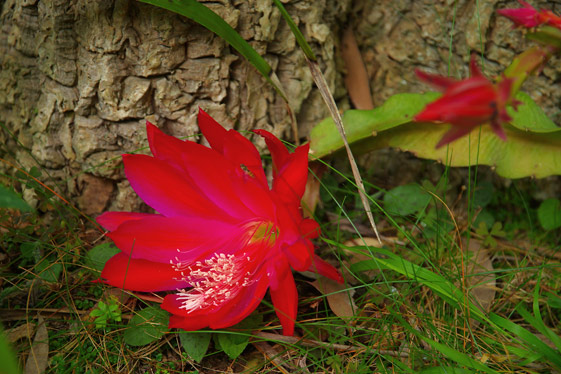 |
| Epiphyllum growing in semi-shade at the base of a Cordyline australis. Here it is creeping along at ground level but in the wild Epiphyllum grows as an epiphyte scrambling up shrubs and tree and attaching itself with aerial roots wherever it can. At Southern Comfort it keeps a 'low profile' - literally. |
Another epiphytic cactus which has surprised me recently is Hatiora - the Easter Cactus. Again, as with other cacti the species is unknown to me and, in any case, it may well be some variety or hybrid. A couple of years ago I placed some segments into a few pockets between the base of Trachycarpus fortunei leaves and the trunk; some sphagnum was added together with a few drops of water. Since the shady position of the position plants was out of sight it soon became out of mind. In the spring of 2018 I was delighted to see several flowers appear from what was a small group of healthy looking plants. Indeed, the plants looked better than the parent plant which had overwintered in the greenhouse. Unfortunately I do not have any photographs of the flowers but no doubt 2019 will provide ample opportunity.
Hatiora is an entirely benign cactus - no spines, no glochids or other nasty surprises (even Epiphyllum manages to field a few small spines from time to time), very floriferous over a long period - in many ways an ideal plant. The variety we have at Southern Comfort has proved itself over a period of several winters. Somewhat surprising, perhaps, for a plant from Brazil. I should mention here that for many years the genera Hatiora and Schlumbergera were effectively interchangeable. This has resulted in much confusion (in my mind included) regarding the identity of particular plants and this is further complicated by the variety of species in each genus. In my case I am simply assuming that the plant we have growing outside is a Hatiora, otherwise known as the Easter Cactus.
The genus Echinopsis has recently been expanded by taxonomists and now inlcudes defunct genera such as Trichocereus, Helianthocereus, Cereus and a few more. There are three species (in addition to the above-mentoned E. oxygona) which I consider to be of value in the U.K.. These are the columnar cacti from the cooler regions of South America. E. spachiana is the Golden Torch Cactus which is a smallish clumping cactus growing up to 1 metre or more in the the South-West U.K.. I originally obtained my stock several years ago from Ray Brown (of Plant World, Newton Abbot, Devon) who asked me whether I would like some unidentified cactus débris he had had lying in dampish shade by a compost heap for several years. 'Obviously very hardy' I thought and happily thanked him for the present. Since then the remnants knocked themselves back into shape and are happily growing and flowering in sunny positions. The flowers are white with only a suggestion of gold in the centre of the flower and the resulting fruits have always contained a mass of seeds (which I have never tried to germinate). Similar in most respects, but with red flowers, is E. huascha (Red Torch Cactus). My form is more spiny than the E. spachiana and is expected to be slightly lower in height. Since it was planted out in the Spring of 2018 we have not yet seen how it would overwinter in the ground; it is probably as hardy as the preceeding species. Both these Torch Cacti are very rapid growers which easily put on 2" (5 cm) or more per year, in addition to offsets.
Probably the most impressive columnar cactus which can be grown outside in the U.K. without any special precautions is E. terscheckii from Argentina. This is not the Saguaro of the North American deserts but it does look similar and could fool many non-experts: it is some 45 cm in diameter, solitary, grows (quickly, it is said) to over 4 metres in height perhaps even up to 10, it branches well above ground level and it is hardy. In
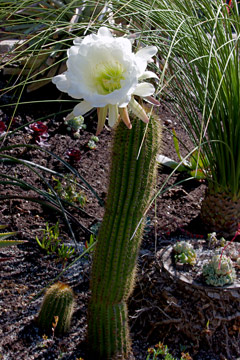 |
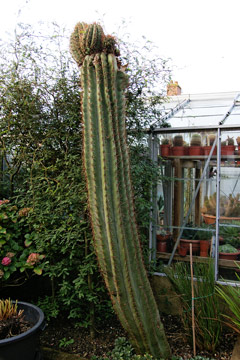 |
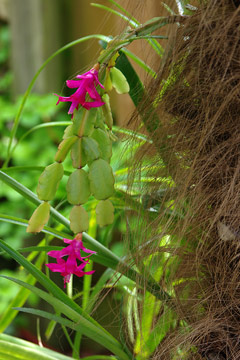 |
| Echniopsis spachiana - the Gold Torch cactus - on a south-facing slope at Southern Comfort. This cactus is fully hardy here and flowers in July; the pleasantly but mildly fragrent blooms last no longer than two days. | An approximately 3 metre high Echinopsis terscheckii in a private garden in Exeter, Devon. It is beginning to branch at the top. | Hatiora on a Trachycarpus in the company of Billbergia nutans. The Hatiora has now overwintered and spread in this position for several years. |
At my age I thought that E. terscheckii was a better bet. However, I soon discovered that it is next to impossible to find and so eventually I had no choice but to grew it from seed obtained from abroad in 2012. The germination rate was high and initially the seedlings grew rapidly with only a few losses. However, when the plants reached a diameter of about 8-9 cm their growth rate slowed considerably. Today (summer 2018) the maximum size remains at 10 cm with the outside ones, of which we have two, slightly larger than the greenhouse-grown ones.
It is likely that the natural growth rate of E. terscheckii varies with its size. Seedlings grow fast and the the plant slows down as it swells and increases in diameter. Finally, at a large diameter stage it re-accelerates upwards. I am only guessing.
E. terscheckii's tolerance of damp is no reason to neglect planting it in a free-draining soil and ensuring that no water ever collects around the base. To minimise the risk of disappointment the well-drained soil/grit mixture used for planting should have a depth of at least 30 cm for a plant of this size and have a diameter somewhat larger than the diameter of the mature column - 50-60 cm in this case. All our cacti and most of our succulents grow on terraces which are effectively raised beds; this ensures that water never gets the chance to gather on the soil surface whilst lessening requirements for grit.
An excellent introduction to growing cacti outside is the book by Leo Chance7 which contains details of far more plants than I could even mention here.
TO BE CONTINUED
Aeonium & Echeveria
1. Such wall
then becomes a 'retaining wall'. There are rules of thumb which apply to
the relationship between the height of the supported earth and the thickness
of the wall. For normal conditions this is 3:1 (level of earth:thickness
of wall) . Ignore those at your peril. In addition, there may be local planning
regulations to satisfy.
2. Irish, Mary & Gary, Agaves, Yuccas and Related Plants, Timber
Press, 2000.
3. Brian Kemble, List of Hardy Aloes, https://www.smgrowers.com/info/brian_aloe.pdf. In my view many of the minimum temparatures given are over-optimistic - for the UK at least.
4. The 2018 mid-March cold spell which averaged lows of about minus 3½°C with below zero temperatures without for several days seriously my A. maculata - the less than ideal location of the plants may have contributed. However, the new plant survived the worst of the cold in my friend's garden with no more than a few mould spots here and there. This plant is generally larger, looks more robust, offsets copiously and even a smallish specimen produced a flwoer spike. Aloe species are known to be quite variable both in appearance and in cold resistance - this case would confirm this view. Further, any initial lack of success with a particular plant needs to be tested with other form - perhaps in a different location.
5. Ben-Erik van Wyk & Gideon Smith (Guide to the Aloes of South Africa, second edn, 2005) give 6 metres as the length of the stems but it is unclear whether this is the height of the plant.
6. According to Kemble. Van Wyk & Smith are less optimistsic: A. brevifolia only minus 4°C and coastal forms of A. humilis not cold hardy at all.
7. Chance, Leo J., Cacti & Succulents for Cold Climates - 274 oustanding species for challenging conditions, Timber Press 2012. This book provides a very good coverage of cacti and yuccas but is relatively weak on agaves and other succulents. It is written primarily for gardening in North America but because it gives minimum temperatures it remains a valuable refenence book for European cactus gardeners.
8. Assuming 25-30 years per generation.